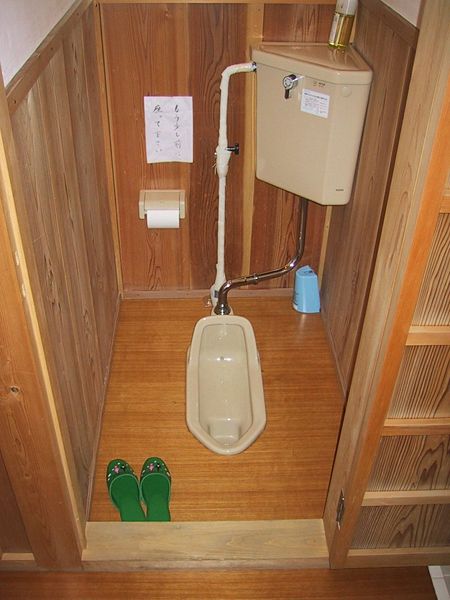Squat toilets
 From Wikidoc - Reading time: 4 min
From Wikidoc - Reading time: 4 min

A squat toilet is a toilet used by squatting, rather than sitting. There are several types of squat toilets, but they all consist essentially of a hole in the ground. The only exception is a "pedestal" squat toilet (pictured here), which is the same height as a standard western toilet.
Types of squat toilets[edit | edit source]
- The squat toilets (known as alaturka (alla turca) in Turkey or Iranian Toilet in Iran,in contrast to alafranga (alla franca) flush toilets) where the user puts his or her feet on foot rests; the user faces the entrance to the cubicle; it is prevalent in Turkey where flush toilets are now getting more in use for households and can still be found in some public buildings and at motorway services in France, Italy, Balkans and, more often, in the former USSR. In India such a toilet is widely used and is referred to as the Indian water closet or the Jodhpur Pan in contrast with the European water closet or EWC or the Western style of toilet. It is also used in the Middle East and can be found in rural areas of Greece and Italy. It is also very common in Iran and prevalent throughout most of South East Asia.
- The Japanese toilet is shaped differently, and the user faces the flush apparatus.
Arguments in favor of squat toilets[edit | edit source]

Proponents of squat toilets argue that:
- It is less expensive and easier to clean and maintain.[1]
- squat toilet does not involve any contact between the buttocks and a potentially unsanitary surface.[2]
- The splashing of water on the buttocks after a heavy defecation does not occur.
- Squatting might help to build the required pressure more comfortably and quickly.[3]
- Squatting makes elimination faster, easier and more complete.[4]
- Elimination in squatting posture protects the nerves that control the prostate, bladder and uterus from becoming stretched and damaged.[5]
- Squatting relaxes the puborectalis muscle which normally chokes the rectum in order to maintain continence.[6]
- Squatting securely seals the ileocecal valve, between the colon and the small intestine. In the conventional sitting position, this valve is unsupported and often leaks during evacuation.[7]
- For pregnant women, squatting avoids pressure on the uterus when using the toilet. Daily squatting helps prepare the mother-to-be for a more natural delivery.[8]
- Haemorrhoids are an extremely common problem, especially in western countries, where surveys suggest that as much as half of the population over 40 years of age may suffer some form of mild to severe discomfort from them. One proposed way to prevent and cure haemorrhoids is to squat for defaecation.[9]
- Squatting may reduce the occurrence or severity of hemorrhoids[10] and possibly other colorectal disorders such as diverticulosis[11] and appendicitis.[12]
Arguments against squat toilets[edit | edit source]
- A common argument against the squat toilet is that if toilet paper is used where there is no flushing system installed, it is easy for the inexperienced user to clog the toilet. Those unfamiliar with the squat toilet should be sure to ask the location of the flushing bucket before attempting use. These buckets flush the toilets manually like a tank would.
- Squat toilets are not accessible to handicapped or disabled persons; to use squat toilets a person must have complete use and mobility of both their legs and arms, which would hinder many people with physical challenges.
- Squat toilets are not like normal toilets and urinals, and can be a shock to people who are used to a sit-down type toilet, and may be difficult to use for the unwary, especially if on trains or ships. Many Britons, having encountered the devices in France and other countries, refer to them euphemistically as "stand and deliver" toilets, a reference to the phrase associated with highwaymen.
Gallery[edit | edit source]
-
Toilet used in passenger trains of China Railway
-
A stainless steel squat toilet found in Hong Kong
-
An older squat toilet
-
Two older adjacent squat toilets
See also[edit | edit source]
References[edit | edit source]
- ↑ "Squatting Pan & Urinal Series.", a
- ↑ "Squatting Pan & Urinal Series.", b
- ↑ Bockus, H.L., Gastro-Enterology, (Philadelphia: W.B. Saunders Co., 1944), Vol. 2, p. 469.
- ↑ Rad, Saeed, "Impact of Ethnic Habits on Defecographic Measurements", Archives of Iranian Medicine, Vol 5, No. 2, April 2002, p.115-117.
- ↑ Tobin, Andrew.. Prostate Disorder – Causes and Cure, National Direct Publishing, Bowden, Australia, 1996, (Chapter 12, by Wallace Bowles, entitled "Refining an Everyday Activity"),p.132
- ↑ Tagart REB. The Anal Canal and Rectum: Their Varying Relationship and Its Effect on Anal Continence, Diseases of the Colon and Rectum 1966: 9, 449-452
- ↑ Welles, William, "The Importance of Squatting" chapter in Tissue Cleansing Through Bowel Management, Bernard Jensen Publisher; 10th Ed edition (June 1981).
- ↑ Russell JGB. Moulding of the pelvic outlet. J Obstet Gynaec Brit Cwlth 1969;76:817-20
- ↑ Christine Dimmer, Brian Martin, Noeline Reeves and Frances Sullivan , "Squatting for the Prevention of Haemorrhoids?", Published in Townsend Letter for Doctors & Patients, 1996: 159, 66-70
- ↑ Sikirov B. A. "Management of Hemorrhoids: A New Approach", Israel Journal of Medical Sciences, 1987: 23, 284-286.
- ↑ Sikirov BA, Etiology and pathogenesis of diverticulosis coli: a new approach, Medical Hypotheses, 1988 May;26(1):17-20.
- ↑ Burkitt DP. Appendicitis. London: Norgine Ltd, 1980
External links[edit | edit source]
| Wikimedia Commons has media related to Squat toilet. |
cs:Turecký záchod de:Hocktoilette he:שירותי בול פגיעה nl:Frans toilet sk:Drepiaca toaleta sv:Fransk toalett
Licensed under CC BY-SA 3.0 | Source: https://www.wikidoc.org/index.php/Squat_toilets37 views | Status: cached on October 09 2025 07:22:25↧ Download this article as ZWI file
 KSF
KSF